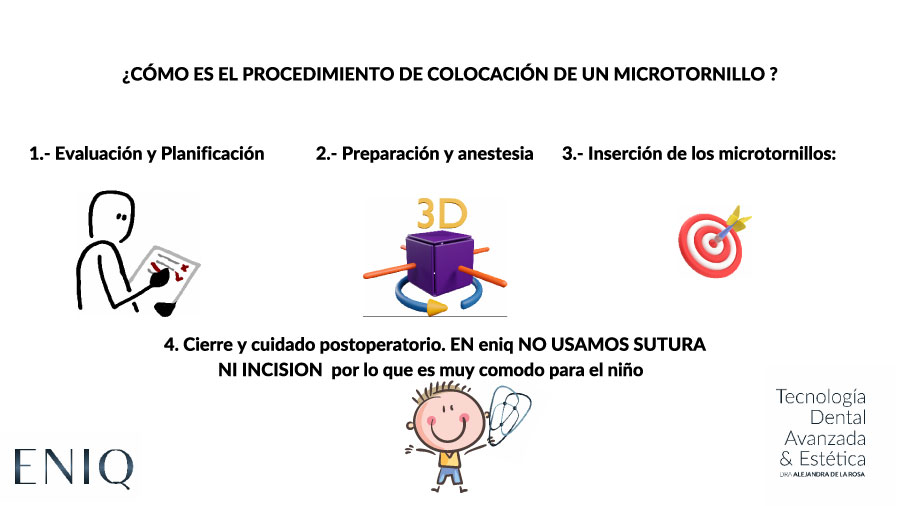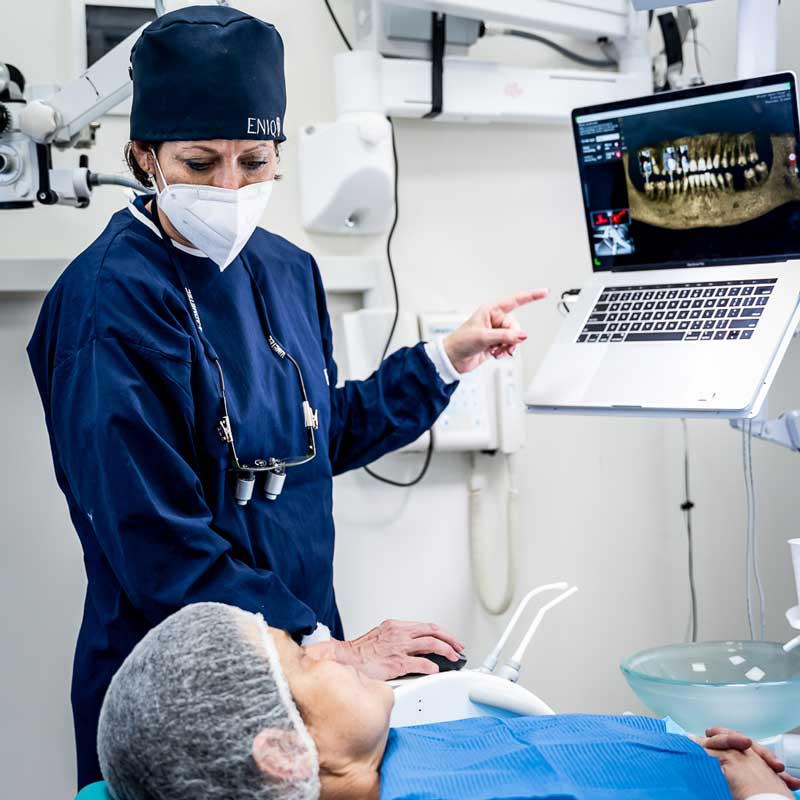

Microscrews
Microscrew treatments for more effective orthodontics
What Are Microscrews and What Are They Used For?
Microscrews, also known as mini-implants or anchorage screws, are small devices used in orthodontics to provide an additional anchorage point during treatment. These screws are made of titanium or titanium alloys and have a shape similar to a conventional screw but are much smaller, typically with a diameter of around 1.2 to 2 mm and a length of 6 to 12 mm.
Microscrews are temporarily inserted into the bone to provide a secure anchorage for orthodontic appliances. They are placed in specific areas of the jaw or maxilla based on the patient's needs and treatment plan. These devices allow orthodontists to apply precise forces to the teeth and better control their movement.
The insertion of microscrews is usually done in the dental office under local anesthesia. A minimally invasive surgical procedure is used to insert the screws into the bone, and once they are correctly placed, force can be applied through the orthodontic appliances to correct the position of the teeth.
One of the advantages of microscrews is that they can provide anchorage in situations where there are not enough teeth available to place bands or tubes. Additionally, they are removable after the treatment is completed.
It is important to note that the placement and use of microscrews should be performed by an experienced orthodontist, as they require special knowledge and skills. An orthodontist will carefully assess the feasibility and need for using microscrews in each particular case before making a decision.
Microscrew Placement Procedure in Orthodontics
The process of placing microscrews in orthodontics:
- Evaluation and planning: The orthodontist will conduct a comprehensive evaluation, including X-rays and dental models, to determine the suitability of microscrews for your case and plan their precise location.
- Preparation and anesthesia: The insertion area will be cleaned and disinfected, followed by local anesthesia to ensure your comfort.
- Insertion of microscrews: A small incision will be made in the gums to access the bone, and the microscrews will be slowly screwed in until they are firmly anchored.
- Securing the microscrews: Once in place, they will be secured to the bone using a special key or instrument to prevent movement during treatment.
- Closure and postoperative care: The gums will be sutured, and instructions for care of the area, including oral hygiene and dietary restrictions, will be provided.
It is normal to experience some discomfort after placement, but it can be relieved with pain relievers. It is important to follow the orthodontist's instructions and attend follow-up visits to monitor the progress of the treatment.

Duration
How many appointments are needed to place microscrews?
The number of appointments required to place a microscrew can vary depending on various factors, such as the complexity of the case and the orthodontist's preferences. Typically, the process of placing a microscrew may take one or two appointments.
In the first appointment, the orthodontist will conduct a comprehensive evaluation of your mouth and plan the precise location of the microscrew based on your treatment needs. During this appointment, the placement of the microscrew can also be done. This involves preparing the area, administering local anesthesia, making a small incision in the gums, and screwing the microscrew into the bone.
In some cases, especially if multiple microscrews are planned for different areas, it may be necessary to schedule a second appointment to complete the placement of the remaining microscrews. During this appointment, the same procedure of preparing the area and placing the microscrew will be followed.
It's important to note that each case is unique, and the exact number of appointments may vary based on individual circumstances. Your orthodontist will provide you with precise information about the number of appointments required for the placement of microscrews in your specific case.


Advantages and Disadvantages of Microscrews in Orthodontics
Advantages:
- Additional anchorage: Microscrews provide an extra anchorage point, improving control over dental movement.
- Versatility: They can be placed in various areas, offering flexibility in different clinical cases.
- Minimally invasive procedure: Their placement is generally straightforward, with less trauma and quick recovery.
- Removable: Microscrews are removable after treatment, without the need for additional surgery.
Disadvantages:
- Require specific skills and experience for proper placement.
- Possibility of complications such as gum irritation or infections, although they are rare.
- Mild postoperative discomfort is common but generally manageable.
It is crucial to discuss with your orthodontist to fully understand the implications of using microscrews.
Microscrews with Invisible Orthodontics
Advantages:
- Additional anchorage: Improves control over dental movement with transparent aligners.
- Precision in dental movement: Allows for more precise and effective adjustments of aligners.
- Reduction in the need for attachments, enhancing the aesthetics and comfort of the treatment.
- Greater versatility in the treatment plan, suitable for more complex cases.
Disadvantages:
- Increased complexity of treatment and requirement for greater experience and skill.
- Temporary discomfort and the need for meticulous oral care.
- Higher cost of treatment compared to aligners alone.
Consult with your orthodontist to determine if this combination is right for you and to receive personalized recommendations.
+90%
What is the success rate with the microscrew technique?
The success rate of microscrews in orthodontics is generally high, typically between 80% and 95%, although this varies depending on the skill of the orthodontist, the implant location, bone quality, and patient cooperation. Success not only depends on correct placement but also on postoperative maintenance and care, including good oral hygiene and regular follow-up visits.
Complications such as gum irritation or loosening of the screws may arise, but they are less common with an experienced orthodontist and adherence to postoperative instructions. For more detailed and tailored information to your situation, it is essential to consult with your orthodontist.
Advantages of treatment with microscrews at ENIQ
The placement of microscrews using technology offers significant advantages over conventional methods, such as:
- Precision: Technologies like three-dimensional imaging, intraoral scanners, and CBCT radiographs allow for more precise planning and placement of microscrews.
- Virtual planning: The use of virtual planning software facilitates simulation and detailed planning of the procedure before execution.
- Placement guides with Dynamic Guided Navigation: Creating customized surgical guides ensures exact and precise positioning during microscrew placement.
- Reduced procedure time: Technology can reduce the time needed for the procedure, resulting in a more efficient experience for the patient.
- Greater patient comfort: The need for traditional impressions is minimized by using intraoral scanners to obtain digital images.
It is essential to consult with an orthodontist who uses these advanced technologies in their clinical practice to take advantage of these benefits.
What is the price of microscrews?
The price of a microscrew (in our dental clinic) is included in the total price of orthodontic treatment. It is not charged per unit because it is not a standalone treatment; it is always part of a treatment plan, and we consider it as a tool to achieve our goals.
From our side, we can tell you that we provide a fixed quote. There are no hidden costs or fine print. It doesn't matter if we need to reposition a microscrew or if you require an extra one midway through the treatment; once we have given you the orthodontic quote, we take care of the materials you need to complete your treatment plan.
Frequently Asked Questions
Do you have more questions about microscrews?
The placement of microscrews in the mouth can cause some discomfort or sensitivity, but the degree of pain varies from person to person. During the procedure, local anesthesia is used to numb the area, which helps minimize pain or discomfort during the insertion of the microscrews. However, you may feel pressure or a slight uncomfortable sensation during the process.
After the procedure, it is normal to experience some degree of discomfort or sensitivity in the area of the microscrews. This may include gum or bone pain during the first few days after placement. The intensity of the pain can range from mild to moderate and can generally be controlled with prescription or over-the-counter pain relievers, as recommended by your orthodontist.
It is important to note that any surgical procedure in the mouth can generate some discomfort, but the pain typically decreases within a few days as the area heals. If you experience severe pain, excessive swelling, persistent bleeding, or any other concerns after the placement of microscrews, it is important to contact your orthodontist for further guidance.
Remember to follow the postoperative care instructions provided by your orthodontist and schedule the recommended follow-up visits to ensure that the healing process progresses properly and orthodontic treatment proceeds as planned.
Previously, certain complex malocclusions were not candidates for invisible orthodontics, but advances in the technique have expanded its scope. Currently, invisible orthodontics has been perfected to correct almost any challenge associated with dental alignment and occlusion.
The choice between invisible orthodontics and conventional braces depends on individual needs and preferences, as well as the professional recommendation of the orthodontist. Each method offers unique advantages and has its own considerations.
Advantages of invisible orthodontics: It offers superior aesthetics with virtually invisible aligners, greater comfort by avoiding wires and brackets, and it is removable for easier oral hygiene and eating.
Disadvantages of invisible orthodontics: It may be less effective in complex malocclusions, tends to have a higher cost, and requires discipline for consistent aligner wear.
Advantages of conventional braces: They are more effective in treating complex malocclusions, are usually more cost-effective, and do not require the discipline of use as with invisible orthodontics, as they are a fixed solution.
Considerations about braces: They have a less aesthetic appearance, can cause discomfort or irritation, and require more attention to oral hygiene and dietary restrictions.
The final decision between invisible orthodontics and braces should be based on a detailed analysis of your specific needs and the guidance of a qualified orthodontist, considering effectiveness, aesthetics, comfort, and costs of each option.
Invisible orthodontics using clear aligners is generally considered one of the least painful orthodontic treatments. It is considered a generally painless orthodontic technique, both during its placement and throughout the treatment.
It is true that invisible orthodontics involves a brief adaptation period, but this is typically shorter than what is needed for traditional braces, usually lasting no more than three or four days.
Services
All rights reserved © ENIQ Clinic 2025
Legal Notice · Privacy Policy · Cookie Policy
